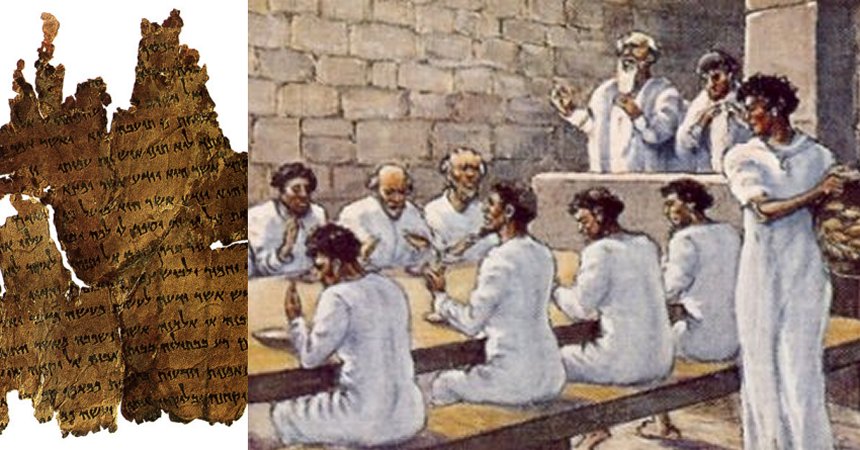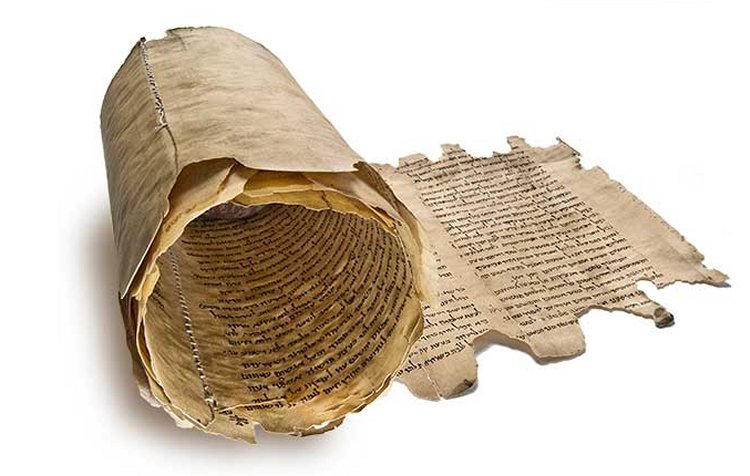Strange Community Rules Of Essenes Preserved In The Dead Sea Scrolls
Jan Bartek - AncientPages.com - Originally known as the Manual of Discipline, the community rules were written during a time when there was political instability in the region and the goal was the create a strong community consisting of very loyal members.
Still, we cannot deny that some of the rules were very strange and a member could be punished for the behavior we today consider quite normal.
The Damascus Document Scroll, 4Q271Df, found in Cave 4. Credit: Public Domain - Right: An ancient sect of the Essenes at the meal table, Qumran. Credit: NCCG
In West Jordan in 1947, near the ruins of Qumran - also known as Khirbet Qumran - clay pots filled with ancient scrolls were found stored in eleven caves, located 13 miles east of Jerusalem, Israel. These ancient manuscripts are today known as the Dead Sea scrolls.
“The texts are written using a carbon-based ink and are mostly in Hebrew, with some in Aramaic (a Semitic language, allegedly spoken by Jesus) and in Greek.
Preliminary analysis showed the texts belonged to the Essenes, members of a religious sect, or brotherhood that flourished in Palestine from about the 2nd century BC to the end of the 1st century AD.
However, a later review of these results has raised additional questions related to the scrolls, considered one of the greatest archaeological events of the twentieth century.
Still not much is known about the Dead Sea Scrolls and the place where they were discovered. There are also many controversies.
One of these issues is for example, who wrote the Dead Sea Scrolls and then hid them away in the caves around Qumran. Some scholars believe that the Essenes were not responsible for the Dead Sea Scrolls at all, but the manuscripts were written by priests of Jerusalem's Second Hebrew Temple and later transported to Qumran and safely hidden from the Romans.
But also, this theory has many opponents.
Was the Vatican behind a plot to suppress the release of the scrolls to the public out of fear that they contained the dangerous material related to early Christianity?” 1
What Can We Learn From The Community Rules?
Wherever we hear loud laughter we automatically see this as a sign of happiness. Granted that laughter can occasionally be inappropriate, but it’s hardly behavior that should be punished, at least not in our modern society, but ancient people were of a different opinion.
According to the community rules of the Dead Sea Scrolls, loud laughter was forbidden among the Essenes, who are generally recognized as the authors of the Dead Sea Scrolls. The community rules reveal a person could be punished and banished from the community for “breaking the social harmony”.
The sect divided humanity between the righteous and the wicked and asserted that human nature and everything that happens in the world is irrevocably predestined.
“The Rule of the Community (1QS), from the Dead Sea Scrolls, sets forth the beliefs and activities of a community of pious sectaries at Qumran in the desert just before the Christian era—what Professor Frank Cross has called a sect (church) of “anticipation.”
Everything is by way of preparation “for the eternal planting of a holy temple for Israel, and the mysteries (secret ordinances) of a holy of holies for Aaron” (1QS VIII, 5–6). Preparation is the theme; hence, it is not surprising that the specific ordinances referred to are the initiatory rites.
But at the same time, the scroll makes clear the ultimate objective of its whole operation—exaltation and eternal lives for the members—while plainly indicating the general nature of the temple activities to which it looks forward with such eager anticipation.
The facsimile of the Manual of Discipline. Credits: Facsimile Editions
The whole theme of religion is eternal life. But beings who would live forever must be prepared to do so—they must be perfect. Nothing but perfection will do for an order of existence that is to last forever and ever.
The striving for perfection is the theme of the Rule of the Community. The sectaries of Qumran knew that the greatest of all prizes were not to be cheaply bought, that there could be no cheating or cutting of corners; to prepare for eternity, one must be willing to go all the way.” 2
The strict rules were meant to prevent negative emotions as well as rivalry and conflicts. Some of the community rules were peculiar or almost a bit funny. For example, you could be punished for falling asleep during a meeting, laughing loud, lying, or speaking rudely.
People who were impatient or sought revenge were also regarded as unwanted members of the community.
If you broke one of the community rules, you could be prohibited from participating in the sect’s activities, like common meals and meetings. If the “crime” was considered severe enough, or someone broke the rules on a regular basis, the member could be expelled from the community.
Written by Jan Bartek - AncientPages.com Staff Writer
Copyright © AncientPages.com All rights reserved. This material may not be published, broadcast, rewritten or redistributed in whole or part without the express written permission of AncientPages.com
Expand for references- Sutherland - Qumran: The Dead Sea Scrolls And Their Connection To Enigmatic Essenes
- Hugh Nibley, From the Dead Sea Scrolls - Studies in the Bible and Antiquity, Vol. 2
Hempel, Charlotte. "Interpretative Authority in the Community Rule Tradition." Dead Sea Discoveries 10, no. 1 (2003): 59-80. Accessed May 17, 2020.
More From Ancient Pages
-
 Unique 1,600-Year-Old Gold Bead Found By Teenager In Jerusalem’s City Of David
Archaeology | Feb 9, 2023
Unique 1,600-Year-Old Gold Bead Found By Teenager In Jerusalem’s City Of David
Archaeology | Feb 9, 2023 -
 Ancient Mystery Of The Unidentified Strangely Dressed Man Found In Massachusetts And His Connection To Undeciphered Rock Carvings
Featured Stories | Sep 19, 2024
Ancient Mystery Of The Unidentified Strangely Dressed Man Found In Massachusetts And His Connection To Undeciphered Rock Carvings
Featured Stories | Sep 19, 2024 -
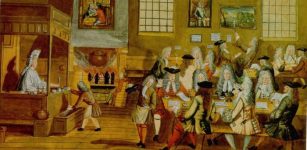 King Charles II Of England Banned Coffeehouses In 1675
Ancient History Facts | Jun 18, 2018
King Charles II Of England Banned Coffeehouses In 1675
Ancient History Facts | Jun 18, 2018 -
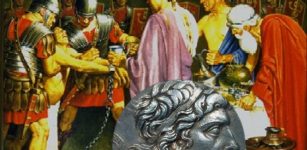 King Mithradates VI Of Pontus Used Poison To Avoid Death By Poison
Ancient History Facts | Mar 5, 2016
King Mithradates VI Of Pontus Used Poison To Avoid Death By Poison
Ancient History Facts | Mar 5, 2016 -
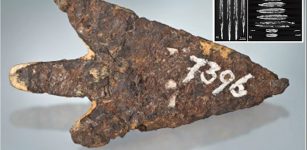 Arrowhead Made Of Meteoritic Iron From The Late Bronze Age Settlement Of Mörigen, Switzerland – Examined
Archaeology | Aug 1, 2023
Arrowhead Made Of Meteoritic Iron From The Late Bronze Age Settlement Of Mörigen, Switzerland – Examined
Archaeology | Aug 1, 2023 -
 Mysterious Valkyrie Eir Remains An Enigma In Norse Mythology
Featured Stories | Apr 4, 2018
Mysterious Valkyrie Eir Remains An Enigma In Norse Mythology
Featured Stories | Apr 4, 2018 -
 Mystery Of The Lost Underground City Of The Grand Canyon
Featured Stories | Nov 19, 2014
Mystery Of The Lost Underground City Of The Grand Canyon
Featured Stories | Nov 19, 2014 -
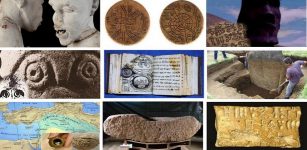 10 Mysterious Undeciphered Ancient Scripts, Tablets, Codes And Maps
Artifacts | Sep 16, 2014
10 Mysterious Undeciphered Ancient Scripts, Tablets, Codes And Maps
Artifacts | Sep 16, 2014 -
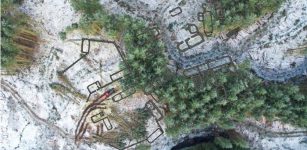 Ruins Of Post-Medieval Brunell Township Discovered In Glen Brittle Forest On The Isle of Skye
Archaeology | Feb 29, 2024
Ruins Of Post-Medieval Brunell Township Discovered In Glen Brittle Forest On The Isle of Skye
Archaeology | Feb 29, 2024 -
 Extraordinary 5,000-Year-Old Astronomical Event Depicted On Indian Rock Carving
Archaeoastronomy | Jan 9, 2018
Extraordinary 5,000-Year-Old Astronomical Event Depicted On Indian Rock Carving
Archaeoastronomy | Jan 9, 2018 -
 On This Day In History: The Lumière Brothers Presented Their First Film In Paris – On Dec 28, 1895
News | Dec 28, 2016
On This Day In History: The Lumière Brothers Presented Their First Film In Paris – On Dec 28, 1895
News | Dec 28, 2016 -
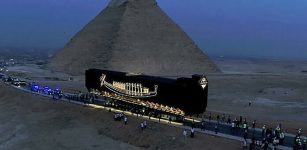 King Khufu’s 4,600-Year-Old Solar Boat Has Been Transported To The Grand Egyptian Museum
Archaeology | Aug 9, 2021
King Khufu’s 4,600-Year-Old Solar Boat Has Been Transported To The Grand Egyptian Museum
Archaeology | Aug 9, 2021 -
 King Solomon’s Copper Mines In The Timna Valley Did Not Pollute Environment – Geochemical Surveys Reveal
Archaeology | Dec 23, 2024
King Solomon’s Copper Mines In The Timna Valley Did Not Pollute Environment – Geochemical Surveys Reveal
Archaeology | Dec 23, 2024 -
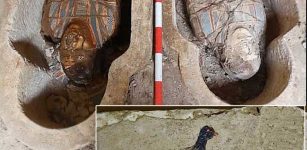 Intriguing Ptolemaic And Roman Treasures Unearthed In Al Bahnasa, Egypt
Archaeology | Jan 10, 2024
Intriguing Ptolemaic And Roman Treasures Unearthed In Al Bahnasa, Egypt
Archaeology | Jan 10, 2024 -
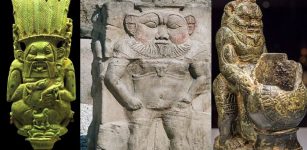 Bes – Ancient Egyptian Dwarf God Of Childbirth, Humor, Song and Dance
Egyptian Mythology | Sep 9, 2016
Bes – Ancient Egyptian Dwarf God Of Childbirth, Humor, Song and Dance
Egyptian Mythology | Sep 9, 2016 -
 Mysteries Of The Yellow Emperor – The ‘Son Of Heaven’ From Regulus
Chinese Mythology | Oct 10, 2021
Mysteries Of The Yellow Emperor – The ‘Son Of Heaven’ From Regulus
Chinese Mythology | Oct 10, 2021 -
 Unusual Ancient Spider Pipes Of Tennessee – Were They Used By Shamans To Enter The Spirit World?
Ancient Mysteries | Feb 18, 2018
Unusual Ancient Spider Pipes Of Tennessee – Were They Used By Shamans To Enter The Spirit World?
Ancient Mysteries | Feb 18, 2018 -
 Ancient Symbol Seed Of Life Contains Hidden Secrets Of The Seven Days Of Creation
Ancient Symbols | Oct 8, 2017
Ancient Symbol Seed Of Life Contains Hidden Secrets Of The Seven Days Of Creation
Ancient Symbols | Oct 8, 2017 -
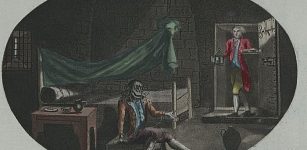 On This Day In History: “Man In The Iron Mask” Died In The Bastille, Paris, France – On Nov 19, 1703
News | Nov 19, 2016
On This Day In History: “Man In The Iron Mask” Died In The Bastille, Paris, France – On Nov 19, 1703
News | Nov 19, 2016 -
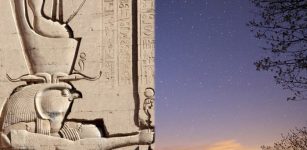 Ancient Egyptians Knew About ‘Demon Star’ Algol’s Variability 3,000 Years Before Western Astronomers
Archaeology | Nov 13, 2018
Ancient Egyptians Knew About ‘Demon Star’ Algol’s Variability 3,000 Years Before Western Astronomers
Archaeology | Nov 13, 2018

